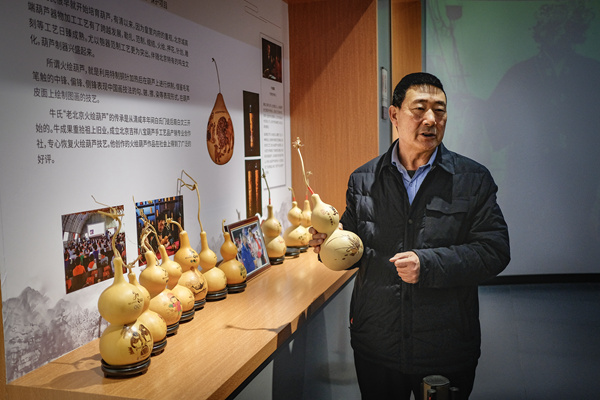

He found electric irons can be used to brand patterns on bottle gourds during his time serving in the military.
"Branding images onto bottle gourds carries a primitive charm," Niu says.
Niu later picked up fine art and calligraphy skills and integrated them with bottle gourd pyrography.
"I'd like to show China's Confucianism, Buddhism and Taoism in my works, in order to raise the cultural and artistic value of fire-painted bottle gourd," he says.
"It would also help the intangible culture heritage to find its place in the new era."
Niu noticed the increasing public interest in the art and, in 2009, decided to set up a bottle gourd art cooperative with his fellow villagers, with the encouragement of local officials.
Niu went from door to door in the neighborhood and managed to recruit more than 60 locals. He then invited experts from colleges to impart bottle gourd planting methods and studied the cultural products market for inspiration.
A gourd planting, processing, artistic creation and sales chain has taken form over the following years, and the cooperative members have grown to 300, 30 percent of whom face life with a disability.
To date, their bottle gourds and related artworks have been sold abroad to Southeast Asian countries.
Per capita annual income among the cooperative members has increased by 18,000 yuan ($2,830).
"The improvement of my family income is the best proof," Niu says.
During this year's Spring Festival, and the Beijing Winter Olympics, the Beijing Municipal Bureau of Culture and Tourism has arranged for more than 300 intangible cultural heritage items to be displayed at the Winter Games venues. Local authorities want athletes to feel the unique atmosphere of Spring Festival amid the intense competition. At the same time, events themed around intangible cultural heritage will be staged in communities and villages across the capital city.
"The 2022 Beijing Olympic and Paralympic Winter Games are not just sports events, but also an exchange of cultures and civilizations," says Zhang Qian, director of the intangible culture heritage division of the Beijing Municipal Bureau of Culture and Tourism.
The concept of openness and sharing is reflected not only in the designs of the sports facilities, but also in the works displayed as part of the cultural exhibition, Zhang adds.
Niu began preparing his bottle gourd artworks for the Winter Olympics in October. He and other artists from the cooperative created about 1,000 works in two months.
"I'm grateful to be participating in the Winter Olympics this way," he says.
In addition to the gourds on display at the Beijing Winter Olympic Village, many were delivered to athletes' rooms.
The idea is to deliver auspiciousness and best wishes to them, Niu says.
Niu has also made a point of publicizing the gourd art.
He has delivered public teaching sessions and developed intangible culture heritage learning activities for pupils in Beijing.
Niu has also answered the call of the Shunyi district authority to help set up gourd plantation and processing cooperative in rural area of Zhangjiakou, Hebei province.
"With all these good news, we just feel more motivated than ever to forge further ahead on our intangible cultural heritage journey," Niu says.